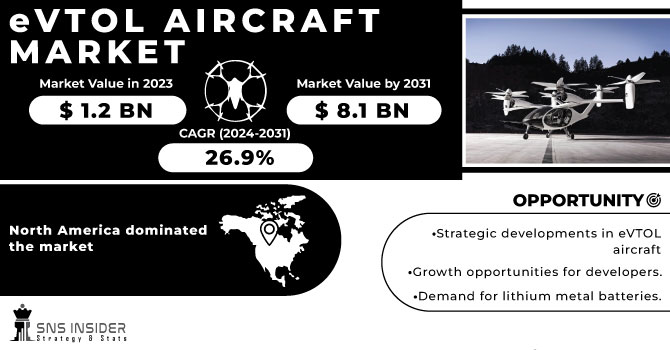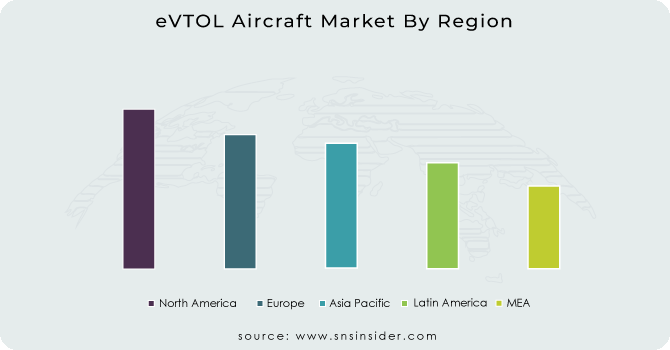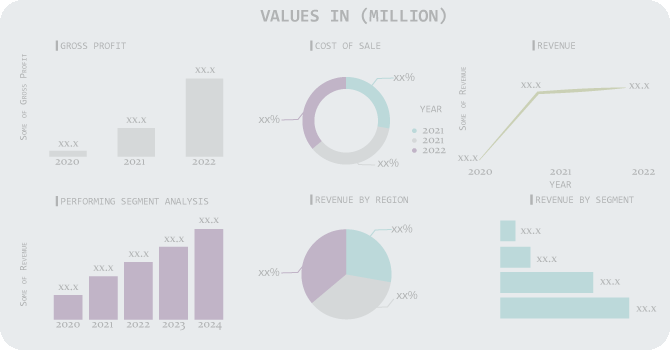eVTOL Aircraft Market Report Scope & Overview:
The eVTOL Aircraft Market size was valued at USD 1.2 billion in 2023 and is projected to reach USD 8.1 billion by 2031 with a growing CAGR of 26.9% during the forecast period 2024-2031.
The growth of this market is mainly driven by the growing need for green energy and noise-free aircraft and the increasing use of eVTOL aircraft for cargo applications and the increasing demand for an alternative mode of transport.

To get more information on eVTOL Aircraft Market - Request Free Sample Report
Electric vertical takeoff and landing aircraft are referred to as eVTOL aircraft. This is a system that deals with self-driving electric airplanes that provide increased services in terms of safety and comfort. They also aid in the production of less noise, resulting in reduced noise pollution. The eVTOL aircraft industry is increasing operating efficiency with the goal of improving customer experience by providing flexibility and convenience. It also aids in speedy transit. These are electric airplanes that do brief tasks at a high pace.
MARKET DYNAMICS
KEY DRIVERS
-
Growing need for green energy and noise-free aircraft.
-
Increase in CO2 emissions.
-
Need for speedy transportation.
RESTRAINTS
-
Complexities of design.
-
Lack of adequate infrastructure.
OPPORTUNITIES
-
Strategic developments in eVTOL aircraft.
-
Growth opportunities for developers.
-
Demand for lithium metal batteries.
CHALLENGES
-
Safety issues
-
Flying would be safe.
THE IMPACT OF COVID-19
The spread of the new Covid-19 has reached historic proportions in the world's mushrooming economy. Most economic sectors have been affected, with aviation being one of the most afflicted. The issue is greater for enterprises involved in the eVTOL aircraft sector. Prior to the pandemic, the eVTOL aircraft market had rapid development while being in its early stages. In certain nations, people expect shared flight models to be reliable. The value proposition varies greatly depending on the travel time on rush trips.
Governments are attempting to designate appropriate budget sections while cooperating with corporations to boost workforce connections in order to mitigate the effects of the epidemic.
IMPACT OF UKRAINE AND RUSSIA CRISIS
International commercial and commercial airlines will experience the effects of the Russian invasion of Ukraine in the form of widespread economic instability, uncertain need for air travel, airline restrictions, and other issues. But the results can vary greatly between regions, carriers, and manufacturers.
While potential conflicts are yet to come, the collision has begun to pose a challenge for air travel. Russia has issued a NOTAM (notification of air traffic control) ban on public flights on Ukraine's northeastern border. That includes the area where Russian troops have gathered in recent weeks. NOTAM is still active until May 18th.
At the same time, Ukraine has closed its airline base, according to an announcement Thursday. Citizens' flight tracking sites now show flights crossing conflicting areas with wide gears.
Competitive Landscape
The subsidiaries of China and Singapore, are expected to grow with a good record by the end of 2027 and have a projected growth record set for the next year 2028. Companies in the Asia-Pacific region are pushing for ever-increasing styles. related to global trade, as well as automation. These agencies set the stage for commercial aviation testing. This will enable these companies to produce large amounts of taxi services, contracts, and partnerships, from the future of 2022.
KEY MARKET SEGMENTATION
By Propulsion Type
-
Fully Electric
-
Hybrid Electric
-
Hydrogen Electric
By MTOW
-
<100 kg
-
100–1000 kg
-
1,000–2,000 kg
-
>2,000 kg
By System
-
Batteries & Cells
-
Electric Motor/Engine
-
Avionics
-
Software
-
Others
By Lift Technology
-
Vectored Thrust
-
Multirotor
-
Lift plus Cruise
By Mode of Operation
-
Autonomous
-
Piloted
By Range
-
<= 200 km
-
> 200 km
By Application
-
Air Taxis
-
Air Shuttles & Air Metro
-
Private Transport
-
Cargo Transport
-
Air Ambulance & Medical Emergency
-
Inspection & Monitoring
-
Surveying & Mapping
-
Surveillance
-
Special Mission
-
Others
REGIONAL ANALYSIS
The e-VTOL aviation market covers areas such as Europe, Asia-Pacific countries, North America, Latin America, Africa and the Middle East. North America dominated the market share for the past year 1028, and the same is expected at the end of the current 2028 forecast period. There are major market players who successfully demonstrate the technology to be used and the new work solutions. There is a growing investment made by the US Army end to acquire aviation market resources and help them reach the market target expected by the end of 2028.
Europe enjoyed the second largest market share at the end of 2022. This has resulted in the acquisition of infrastructure, the development of flexible designs, and, west port channels. The Canadian military also opted for investment to encourage developers related to military eVTOL services. The airline segment is expected to have the highest market value by the end of the forecast period 2022-2028. 28.98% CAGR growth is expected in the airbus sector by the end of the 2028 forecast period. This makes less noise compared to a normal airplane.

Need any customization research on eVTOL Aircraft Market - Enquiry Now
REGIONAL COVERAGE:
North America
-
USA
-
Canada
-
Mexico
Europe
-
Germany
-
UK
-
France
-
Italy
-
Spain
-
The Netherlands
-
Rest of Europe
Asia-Pacific
-
Japan
-
South Korea
-
China
-
India
-
Australia
-
Rest of Asia-Pacific
The Middle East & Africa
-
Israel
-
UAE
-
South Africa
-
Rest of Middle East & Africa
Latin America
-
Brazil
-
Argentina
-
Rest of Latin America
KEY PLAYERS
The key players are Jaunt Air Mobility, Lilium, EHang, Airbus SE, Elbit Systems, Bell Textron Inc., Embraer SA, Isreal Aerospace Industries, Pipistrel, Elroy AIR, Joby Aviation, Archer Aviation Inc., SZ DJI Technology Co. Ltd., Samad Aerospace, Aurora Flight Sciences, vertical Aerospace Group Ltd., Urban Aeronautics Ltd. and Other Players
Airbus SE-Company Financial Analysis

| Report Attributes | Details |
|---|---|
| Market Size in 2023 | US$ 1.2 Billion |
| Market Size by 2031 | US$ 8.1 Billion |
| CAGR | CAGR of 26.9% From 2024 to 2031 |
| Base Year | 2023 |
| Forecast Period | 2024-2031 |
| Historical Data | 2020-2022 |
| Report Scope & Coverage | Market Size, Segments Analysis, Competitive Landscape, Regional Analysis, DROC & SWOT Analysis, Forecast Outlook |
| Key Segments | • By Propulsion Type (Fully Electric, Hybrid Electric, Hydrogen Electric) • By MTOW (<100 kg, 100–1000 kg, 1,000–2,000 kg, >2,000 kg) • By System (Batteries & Cells, Electric Motor/Engine, Aerostructures, Avionics, Software, Others) • By Lift Technology (Vectored Thrust, Multirotor, Lift plus Cruise) • By Mode of Operation (Autonomous, Piloted) • By Range (<= 200 km, > 200 km) • By Application (Air Taxis, Air Shuttles & Air Metro, Private Transport, Cargo Transport, Air Ambulance & Medical Emergency, Last Mile Delivery, Inspection & Monitoring, Surveying & Mapping, Surveillance, Special Mission, Others) |
| Regional Analysis/Coverage | North America (USA, Canada, Mexico), Europe (Germany, UK, France, Italy, Spain, Netherlands, Rest of Europe), Asia-Pacific (Japan, South Korea, China, India, Australia, Rest of Asia-Pacific), The Middle East & Africa (Israel, UAE, South Africa, Rest of Middle East & Africa), Latin America (Brazil, Argentina, Rest of Latin America) |
| Company Profiles | Jaunt Air Mobility, Lilium, EHang, Airbus SE, Elbit Systems, Bell Textron Inc., Embraer SA, Isreal Aerospace Industries, Pipistrel, Elroy AIR, Joby Aviation, Archer Aviation Inc., SZ DJI Technology Co. Ltd., Samad Aerospace, Aurora Flight Sciences, vertical Aerospace Group Ltd., Urban Aeronautics Ltd. |
| Key Drivers | • Growing need for green energy and noise-free aircraft. • Increase in CO2 emissions. |
| RESTRAINTS | • Complexities of design. • Lack of adequate infrastructure. |

